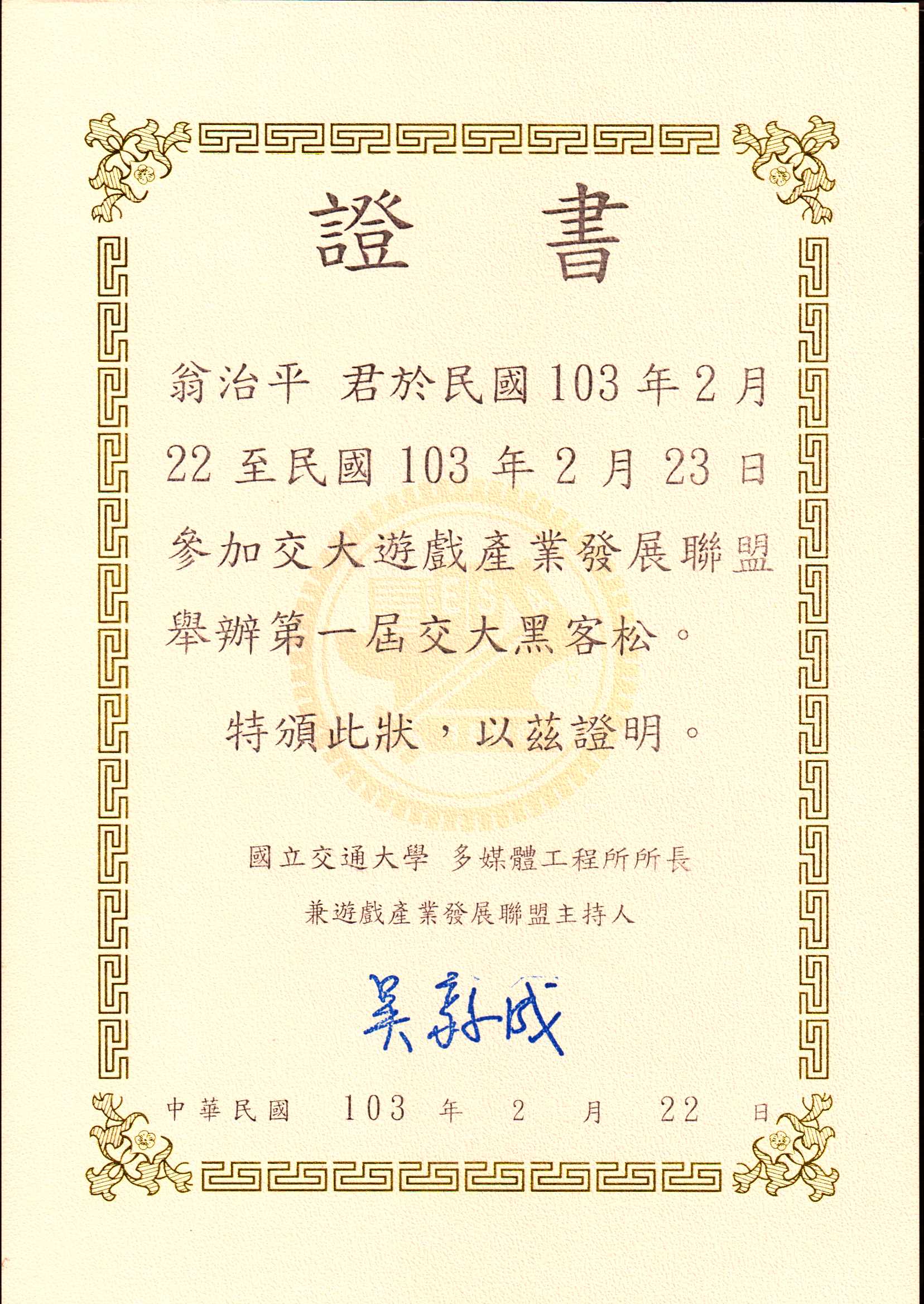CV
Chih-Ping Weng#
- Github: https://github.com/gocreatingopen_in_new
- Blog: https://gocreating.lation.appopen_in_new
- LinkedIn: https://www.linkedin.com/in/gocreatingopen_in_new
- CakeResume: https://www.cakeresume.com/gocreatingopen_in_new
- Download Reseme
Work Experience#
Senior Backend Engineer, ĒSEN Inc.open_in_new#
2022.03 - 2023.01
- Kicked off both business-facing and customer-facing projects with microservice architecture and domaindriven design (DDD) pattern
- Implemented a reservation system with optimistic lock strategy to prevent double booking
- Implemented the design system Essence to modularize and accelerate frontend development
Senior Backend Engineer, OneDegreeopen_in_new#
2020.05 - 2022.03
- Implemented OneDegree Query Language (ODQL) as an alternative query style versus RESTful APIs
- Refactored legacy payment gateway interface to make it easier to integrate with different customers’ payment systems
- Implemented an event sourcing mechanism for internal data aggregation and analytics
- Led a 5-member backend squad, mentored team members on technical skills, and was in charge of backend system design as well as technical interviews
Frontend Engineer, Appieropen_in_new#
2019.04 - 2020.05
- In charge of frontend software development (react, vanilla js)
- In charge of mobile ads sdk development and demo appopen_in_new (android)
- Take care minor backend development (flask, aiohttp, bottle)
- Take care minor operation and monitoring (gke, k8s, docker)
- Do agile coaching (scrumban)
Side Project - Scriboopen_in_new#
2018.09 - 2019.06
I implemented this blog service featured with a modular and powerful editor. Welcome to signup and try it! If you think this is a good idea, you can also give donationopen_in_new to me through ecpay service.
Intern, MVP Fastlaneopen_in_new, Taiwan#
2018.09 - 2018.11
Work on an interesting IoT service to help people to take care of their eye health. The challenges included
- code refactoring
- bluetooth/BLE communication
- product hosting on AWS
- co-working with Indian and American engineers
Side Project - someguy.ioopen_in_new#
2017.07 - 2017.11
An experimental blog service shipped with pretty WYSIWYG editor and comprehensive social integrations.
Full Stack Web Developer, Caserhubopen_in_new, Taiwan#
2016.10 - 2017.12
Kickstarted a service of a startup company from scratch, including frontend development, backend development, version control, and operation.
Freelance Web Developer, 旺仔俱樂部open_in_new#
2015.01 - 2015.03
Migrated, maintained and upgraded the backend of the website of 旺仔俱樂部 from Asp.Net to Nodejs.
The topic lives, SDN program in NCTU#
2014.10 - 2015.07
Launched an open source project Seedopen_in_new, which helps developers speeding up the process of developing a website with Express and Angular.
Part-time Worker, NCTU Computer Center#
2014.08 - 2016.07
Built the admin and management systems with python and django.
Freelance Web Developer#
2014.06
Developed the backend website of 新北市生技產業發展聯盟.
Backend Engineer, Startup 隔壁老王的實驗室#
2013.09 - 2013.11
Developed the backend and the architecture of the website service and product.
Intern, NCHC#
2013.07 - 2014.08
Implemented social login system for the admin system of ezCloud service in PHP.
Research Experience#
Publication#
- Lin, C. Y., Weng, C. P., Wang, L. C., Shuai, H. H., & Tseng, W. P. (2019). Edge-Based RNN Anomaly Detection Platform in Machine Tools. Smart Science, 1-8.
Master Thesis#
2016.09 - 2018.08
-
With the rapid advances of machine learning algorithms and sensing technologies, machine prognostics and health management (PHM) via data-driven approaches has become a trend in sophisticated machine tool industry. Recurrent neural network (RNN) is an important technique to process the sequential sensing data. Two popular PHM approaches are: 1) predicting the remaining useful life (RUL) of a machine, and 2) applying anomaly detection (AD) on a machine. Run-to-failure data is necessary to train RUL-based models. During the process of collecting run-to-failure data, a machine may face the situation of abnormality, such as impulse signals, before it fails. Therefore, AD-based approaches, which aim to detect anomalies in real-time, are more suitable for machine tool industry compared to RUL approaches. However, due to vanishing gradient problem in RNN, it is difficult and time-consuming to train an RNN model. To this end, we propose a framework, called QUAntized Recurrent neural network autoencoder for Time-series anomaly detection (QUART), to accelerate the RNN model training for the abnormality detection. The main idea of QUART is to reduce data size by mapping raw data into finite classes according to the probability mass in the raw data. To learn the anomaly states without considering the sequence order of sensing values in a short interval, we adopt a data shuffling method to increase the variance of the training data. Our experiment results show that the proposed framework can accelerate almost 120 times faster than the existing RNN methods.
Education#
Master of Computer Science#
2016.09 - 2018.08
Institute of Network Engineering, College of Computer Science, National Chiao Tung University, Taiwan, R. O. C.
Bachelor of Computer Science#
2012.08 - 2016.06
Department of Computer Science (Network and Multimedia Engineering Program), National Chiao Tung University, Taiwan, R. O. C.
Achievements & Honors#
Won the 2nd place in the Spintech Technology Thesis Award 2018open_in_new(旭泰科技論文獎)#
2018.08
- Title: QUART: Quantized RNN Autoencoder for Time-Series Anomaly Detection in Machine Tools
Preferred Award in the 8th iThome Iron Man Challengeopen_in_new(iT邦幫忙鐵人賽)#
2016.12
Preferred Award in NTU 2B Hackathonopen_in_new#
2015.05
- Stack: NodeJs, Android
- Team Size: 2
- Stack: NodeJs、Microsoft Azure
- Team Size: 4
Tutor#
2014.06 - 2014.08
Taught HTML and CSS to 2 students.
- Stack: NodeJs, MySQL, Amazon Web Service
- Team Size: 3
Won the 1st place in the 1st NCTU Hackathon 2014open_in_new78#
2014.02
- Stack: NodeJs, MongoDB, Amazon Web Service
- Team Size: 4
President, Computer Club of Chia-Yi Senior High School (CYSH)#
2010.06 - 2011.06
Presentations / Talks / Workshops#
菜鳥工程師軟體經驗談, Yuan Ze University#
2020.09.18
AI資料科學專業人才養成班open_in_new#
2020.08.10 - 2020.08.11
Introduce from scratch basic python syntax, patterns and case studies to students.
Present my personal ongoing research on smart manufacturing.
Technical Skills#
Backend | Python, FastAPI, SQLAlchemy, Node.js, Express.js |
Frontend | React, Redux, Next.js, Mocha |
Database | PostgreSQL, MySQL, MongoDB |
CI/CD | Circle CI, Travis CI |
Infra | GCP, Docker, Kubernetes, Heroku |
Data Science | Deep Learning (mainly RNN, recurrent neural networks), Numpy, Pandas, Tensorflow, Keras |
Workflow | Git, Github, Gitlab, Jira, Clickup, Slack |
Portfolio#
Please refer to portfolio page.


.jpg)




.jpg)